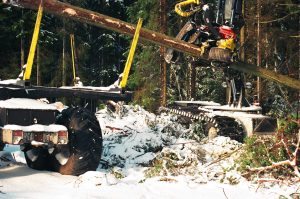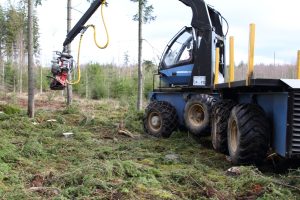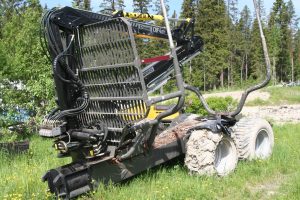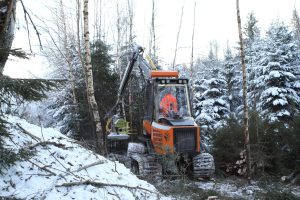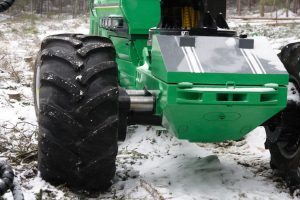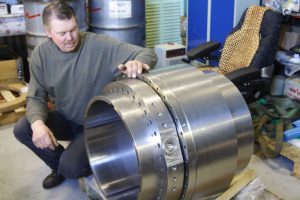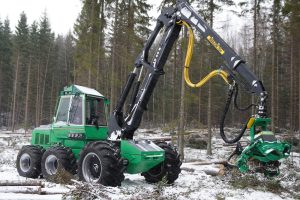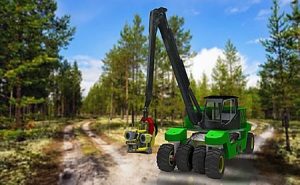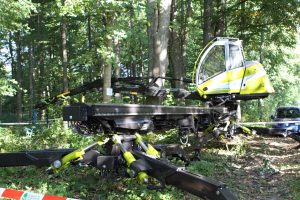Today’s forestry machinery wasn’t born overnight. It took some thinking and testing before the machines looked like they do today. But to be quite honest, the differences are minor if you look at the machines from the late ’80s compared with today. Nowadays, we don’t see any significant steps in the development of forest machinery. Have forestry people stopped thinking and testing?
Machines that could have been something
No, they haven’t, is a short answer to that question. But it somehow seems more difficult today to get new ideas on the market. Or are the ideas not so good anymore?
It’s difficult to say. Back in the ’50s, ’60s, and ’70s, the machine manufacturers and inventors got help from the forest industry. I recall one man who was there back then telling me that if someone had a prototype of a new machine, an extensive forest company would buy 10 or 15 of those just for testing. By doing that, they helped the manufacturer with the financing of the development. Unfortunately, that has not been common since the ’70s.
Of course, not all those prototypes turned out to be a success. But as someone bought the machines, the development could continue. Eventually, there was a range of good machines to choose from, and then the development stopped. To clarify, one might say that from the mid-’80s, and onward it has only been fine-tuning of the concepts developed in the ’60s and ’70s.
The pioneers are still here
They and their machines are just not so visible anymore. It seems as if the forestry business has decided that we have the machines that we need and we need no more new ones. But there are still people out there thinking, drawing, welding, and testing new ideas. The difference is that it’s hard for them to get financing as no one is buying their prototypes and concepts.
I want to mention a few machines and inventors that I have come across. Some are still around and active, and others are gone. If the ideas were good or not is up to everyone to figure out:
Christer Lennartsson
One such inventor here in Sweden is Christer Lennartsson, who is the man behind the remote-controlled harvester “Besten” (the Beast) and its forwarder “Kuriren” (the Courier). Among his last projects, the Fiberdrive 1750 harvarder and the Fiberdrive 9.5 harvester should be mentioned. He managed to (partly) finance his projects as one of his inventions, the Fiberpac slash bundler, actually was sold to one of the major manufacturers.
The principle of Besten and Kuriren was that the harvester (Besten) was controlled from the forwarder (Kuriren), the logs were processed directly onto the loading area of the forwarder, and when the load was full, a second Kuriren took over as the first went to the landing to unload. This meant that two persons controlled three machines.
There was research and testing of the system with mixed results. Eventually, the system was sold to Gremo, who displayed it on the Elmia show in 2009, after which it has been very silent around the system.
The Fiberdrive 1750 is a 10-wheeled combined harvester and forwarder with a unique quick coupling that makes it possible to switch between the harvester head and grapple within seconds. Also, the leveling system of the machine is unique as each wheel is mounted on its pendulum arm. Here is a short film made by Swedish State Forest, Sveaskog, at a demo of the Fiberdrive 1750.
This pendulum arm system came back in the Fiberdrive 9.5 harvester that we wrote about last year. It’s a computer-controlled system that always keeps the machine level automatically. The 1750 was meant for clear-cuts and the 9.5 for thinning.
Two or three(?) “Besten and Kuriren” systems were built, but the system never broke through. The concept was later sold to Gremo, who today is a part of Eco Log. So, what became of the Beast is unknown to me. The 1750 was, as far as I know, only built-in one copy. The 9.5 is meant to be a concept machine where different technical solutions are tested and might suit other machines.
Other combi machines
Other combi machines have been on the market. One that turned up at the Elmia show in 2007 was the harvester/forwarder Forestline. The unique thing about the Forestline concept was that it didn’t only switch the loading area and the grapple/harvester head, the whole rear part of the machine was switched, including the crane. The switch was made in about six minutes.
A small company made the Forestline in north Sweden. Unfortunately, it seems that they have disappeared from the market. I don’t know how many machines they produced.
Here is a walk-around film made by the sister site Skogsforum.se six years ago. And here is a film made by the Forestline manufacturer that shows how the switch is done.
Timbear is a tracked combi machine that has been on the market for some time. Due to its size and the tracks, it was suitable for wet and soft soil in thinning. The switch harvester-forwarder is made in some 20 minutes. Here is a film that shows the switch.
Also, the Timbear is no longer on the market except for second-hand ones that occasionally pop up. So I don’t know how many machines were produced.
Not the only bear in the forest
The Swedish contractor and inventor Torbjörn Ericsson built his harvester named T-Bear. The T-Bear has mainly two unique features: Adjustable width and voice control.
The adjustable width is achieved thanks to a unique hub that Torbjörn invented. The hub makes it possible to change the width hydraulically without affecting any other functions of the machine. The idea with the adjustable width is to combine stability with the ability to operate along narrow strip roads in thinning.
The voice control is simply a feature to save the operator’s fingers from the classic “knitting injuries” that many machine operators get after some decades behind the controls. For example, to use the voice instead of pushing buttons, spare the fingers. The voice control could be set individually for each operator, meaning that different dialects or languages are no problem (according to the inventor).
Here is a film produced by Elmia where Torbjörn talks about his machine – the T-Bear.
Only one copy was built of the T-Bear. If I know Torbjörn Ericsson right, he uses it daily. However, I haven’t spoken to him in many years, so I can’t be sure.
Not all reached the forest
The machines mentioned above all exist, even though some of them only were built in one copy. The German contractor and inventor Jürgen Hartig invented a concept on the drawing board. It’s a machine with adjustable width and height, driven by electrical motors at each of the eight wheels. Jürgen had built one machine before, a harvester that he used in his daily business as a forest contractor for many years. That machine was more traditional than the new idea that he had. His problem is that he is 70+ and has neither time nor the energy to move on with the project. So, he searches for someone else to take over his electrical pendulum arm harvester.
You can read a previous article about Jürgen’s electrical harvester here.
Illustration: Harvest Forsttechnik GmbH
A look ahead
At the beginning of this article, I asked if the forestry people had stopped thinking. They haven’t. There are not only inventors like Christer, Torbjörn, and Jürgen sitting out in the bushes having bright ideas. Also, more official parties in forestry have ideas.
Both Luleå Technical University and Skogforsk in Sweden are looking at new machine concepts. So is Dresden Technical University in Germany. You can read about those projects by clicking on the names in this paragraph.
It’s a good sign that there are so many ideas out there, after all. In this article, I have only mentioned a few. But I find it a bit worrying that the major forest machine manufacturers show so little interest in the new ideas that pop up. So it seems that the next major step in the development of forest machinery is far away. I hope I’m wrong.
Sources: Sveaskog, Skogforsk, Forestline, Timbear, Luleå Technical University, Dresden Technical University, Harvest Forsttechnik GmbH, and Elmia.
Photos: Per Jonsson, where not otherwise stated.






